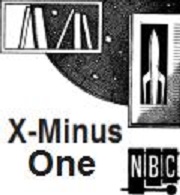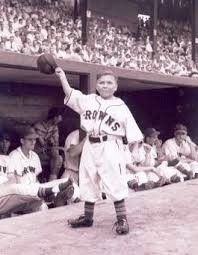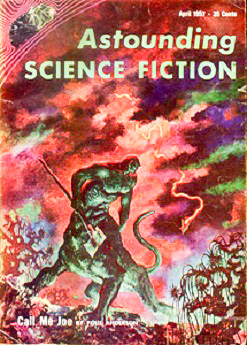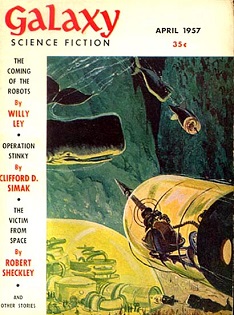
 X Minus One (1955-58) aired “Martian Sam” on April 3, 1957 as the 95th of its estimated 125 original episodes (there were a few rebroadcasts). All but a handful are still counted as being “in circulation.” Ernest Kinoy (April 1, 1925-November 10, 2014) wrote the original script especially for X Minus One. It was Kinoy and George Lefferts who would adapt all but a few of the episodes from originally printed material in two SF magazines (first Astounding and then Galaxy–with Lefferts’ adaptation of the Stephen Vincent Benet poem “Revolt of the Machines” as “Nightmare” being the sole exception), but on occasion they both contributed original material, of which “Martian Sam” is one.
X Minus One (1955-58) aired “Martian Sam” on April 3, 1957 as the 95th of its estimated 125 original episodes (there were a few rebroadcasts). All but a handful are still counted as being “in circulation.” Ernest Kinoy (April 1, 1925-November 10, 2014) wrote the original script especially for X Minus One. It was Kinoy and George Lefferts who would adapt all but a few of the episodes from originally printed material in two SF magazines (first Astounding and then Galaxy–with Lefferts’ adaptation of the Stephen Vincent Benet poem “Revolt of the Machines” as “Nightmare” being the sole exception), but on occasion they both contributed original material, of which “Martian Sam” is one.
“Martian Sam” appeals to me at this time of year for two reasons: firstly, it is about baseball–albeit in the early 21st century–and diehard baseball fans in this summer of 2016 will appreciate the timeless problems the fictional manager deals with when the owner of the L.A. Dodgers has died and passed the franchise to his son, who cares little for baseball and will not support the team. The Dodgers are in last place and in sore need of a pitcher and a few good players to contend, but the new owner isn’t willing to spend the money to acquire them. Sound familiar? Such has been the plight of, and contention between owners and managers virtually since the game was invented and continues to this day. But through a happy circumstance, the young owner comes through with the best pitcher the sport has ever seen–and who just happens to be an alien from Mars who stands 18″ high and whose pitching arm is 32 feet long. Which brings me to the second reason “Martian Sam” appeals to me; it’s unabashed insider humor, for more often than not humor in SF is the Rodney Dangerfield of sub-genres in that “it don’t get no respect.”
 I believe Kinoy found his inspiration for this story in one of major league baseball’s most famous incidents. While the real life ending is different than the one Kinoy wrote for “Martian Sam” (and thus I won’t be giving away the ending), I think to appreciate Kinoy’s story we need to travel back in our time machine to August 19, 1951, when the St. Louis Browns played a day-night doubleheader with the Detroit Tigers. Browns owner Bill Veeck was known to love publicity stunts and was quite the showman. As part of a series of surprises Veeck had promised the press and fans for the doubleheader, in the bottom of the first inning of the second game Veeck trotted out a dwarf as a lead-off pinch hitter. His name was Eddie Gaedel, he stood 3’7″ tall, and wore the number “1/8” on his uniform. Gaedel was instructed in no uncertain terms that he was not to take the bat from his shoulder, that he was at the plate to get a walk. Gaedel had been instructed by Veeck how to crouch at the plate, giving Detroit pitcher Bob Cain a miniscule strike zone of one and one-half inches. As expected, Gaedel walked on four straight pitches. On his way to first base it is reported that he stopped and bowed to the crowd of 18,000+ twice, and then was replaced by a pinch runner upon reaching first. The crowd gave Gaedel a standing ovation. The Tigers, however, despite the Browns’ stunt, won the game 6-2, overshadowing Veeck’s grandstand stunt with Gaedel. There’s more to the story of course, including how Gaedel’s contract signing a mere 48 hours before the game did not give the league office time to approve the contract, which it later did. But Gaedel, as baseball’s most famous pinch-hitter, changed the game forever when the rules were changed so that all contracts from that point on needed approval by the Commissioner of Baseball prior to a player being allowed on a team’s official roster.
I believe Kinoy found his inspiration for this story in one of major league baseball’s most famous incidents. While the real life ending is different than the one Kinoy wrote for “Martian Sam” (and thus I won’t be giving away the ending), I think to appreciate Kinoy’s story we need to travel back in our time machine to August 19, 1951, when the St. Louis Browns played a day-night doubleheader with the Detroit Tigers. Browns owner Bill Veeck was known to love publicity stunts and was quite the showman. As part of a series of surprises Veeck had promised the press and fans for the doubleheader, in the bottom of the first inning of the second game Veeck trotted out a dwarf as a lead-off pinch hitter. His name was Eddie Gaedel, he stood 3’7″ tall, and wore the number “1/8” on his uniform. Gaedel was instructed in no uncertain terms that he was not to take the bat from his shoulder, that he was at the plate to get a walk. Gaedel had been instructed by Veeck how to crouch at the plate, giving Detroit pitcher Bob Cain a miniscule strike zone of one and one-half inches. As expected, Gaedel walked on four straight pitches. On his way to first base it is reported that he stopped and bowed to the crowd of 18,000+ twice, and then was replaced by a pinch runner upon reaching first. The crowd gave Gaedel a standing ovation. The Tigers, however, despite the Browns’ stunt, won the game 6-2, overshadowing Veeck’s grandstand stunt with Gaedel. There’s more to the story of course, including how Gaedel’s contract signing a mere 48 hours before the game did not give the league office time to approve the contract, which it later did. But Gaedel, as baseball’s most famous pinch-hitter, changed the game forever when the rules were changed so that all contracts from that point on needed approval by the Commissioner of Baseball prior to a player being allowed on a team’s official roster.
St. Louis Browns owner Bill Veeck continued to employ Gaedel (and other dwarves) for promotional stunts over the next several years. One such stunt is recounted on Gaedel’s wikipedia entry, and will be of humorous interest to SF fans: “In 1959, Gaedel and three other dwarfs dressed as spacemen were seen presenting “ray guns” to White Sox players Nellie Fox and Luis Aparicio at Comiskey Park. (Gaedel reportedly said, “I don’t want to be taken to your leader. I’ve already met him.”) In 1961, Veeck (who by that time had become owner of the White Sox) hired several dwarfs and midgets, including Gaedel, as vendors, so as not to “block the fans’ view” of the game.”
I hope you enjoy “Martian Sam” and will appreciate that in fiction as in real life, sometimes size (even small) does matter. And don’t try to guess the ending to this one or you’ll miss the point of the real life story recounted above. Have fun.
Play Time: 21:09
{April of 1957 found the neighborhood crew of junior spacemen full of energy, imaginations afire, as they headed for the corner drugstore in search of their favorite reading material. Astounding, a venerable mainstay, held firm with its monthly schedule. Of note is Poul Anderson’s cover story “Call Me Joe,” which was included in The Science Fiction Hall of Fame, Volume Two, ed. Ben Bova (1973). Galaxy‘s first issue hit the newsstands in October of 1950 and in 1957 hadn’t missed a beat, maintaining its monthly schedule as well. IF, Worlds of Science Fiction was Galaxy‘s sister magazine, seeing its first issue in March of 1952. Begun as a bi-monthly, if flirted with a monthly schedule on two occasions but ultimately ended its run as a bi-monthly with its Nov./Dec. 1974 issue.}
[Left: Astounding, April 1957 – Center: Galaxy, April 1957 – Right: If, Worlds of Science Fiction, April 1957]



To view the entire list of weekly Old Time Radio episodes at Tangent Online, click here.